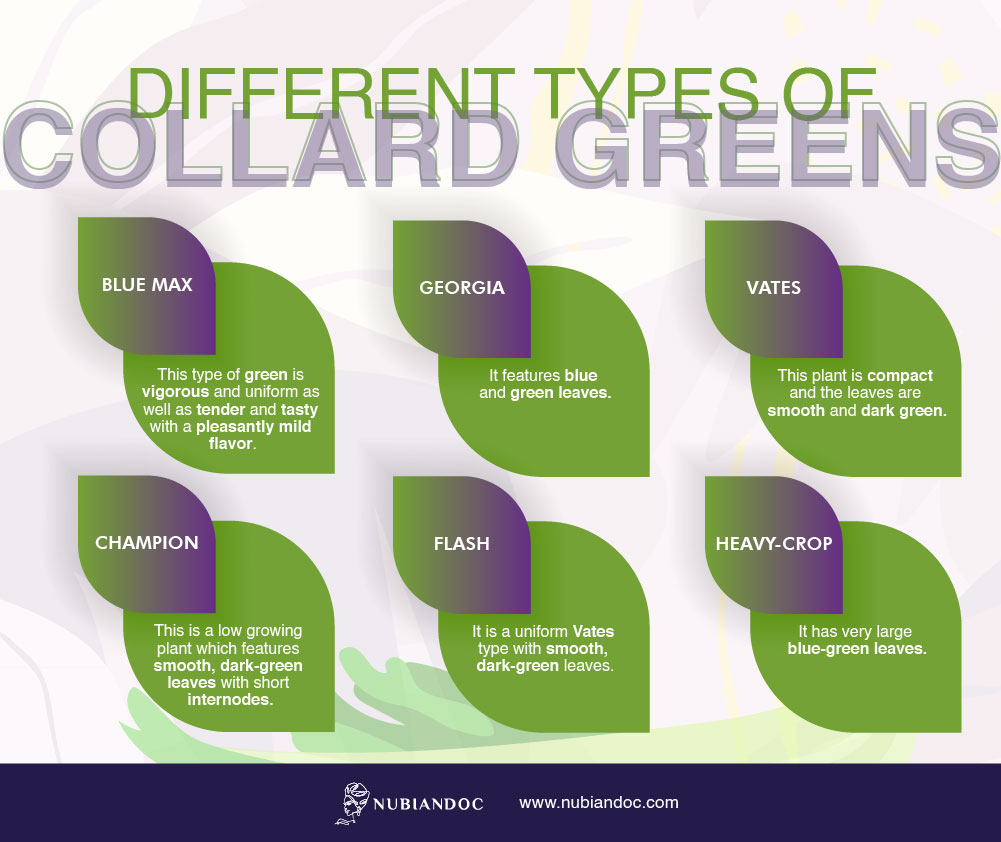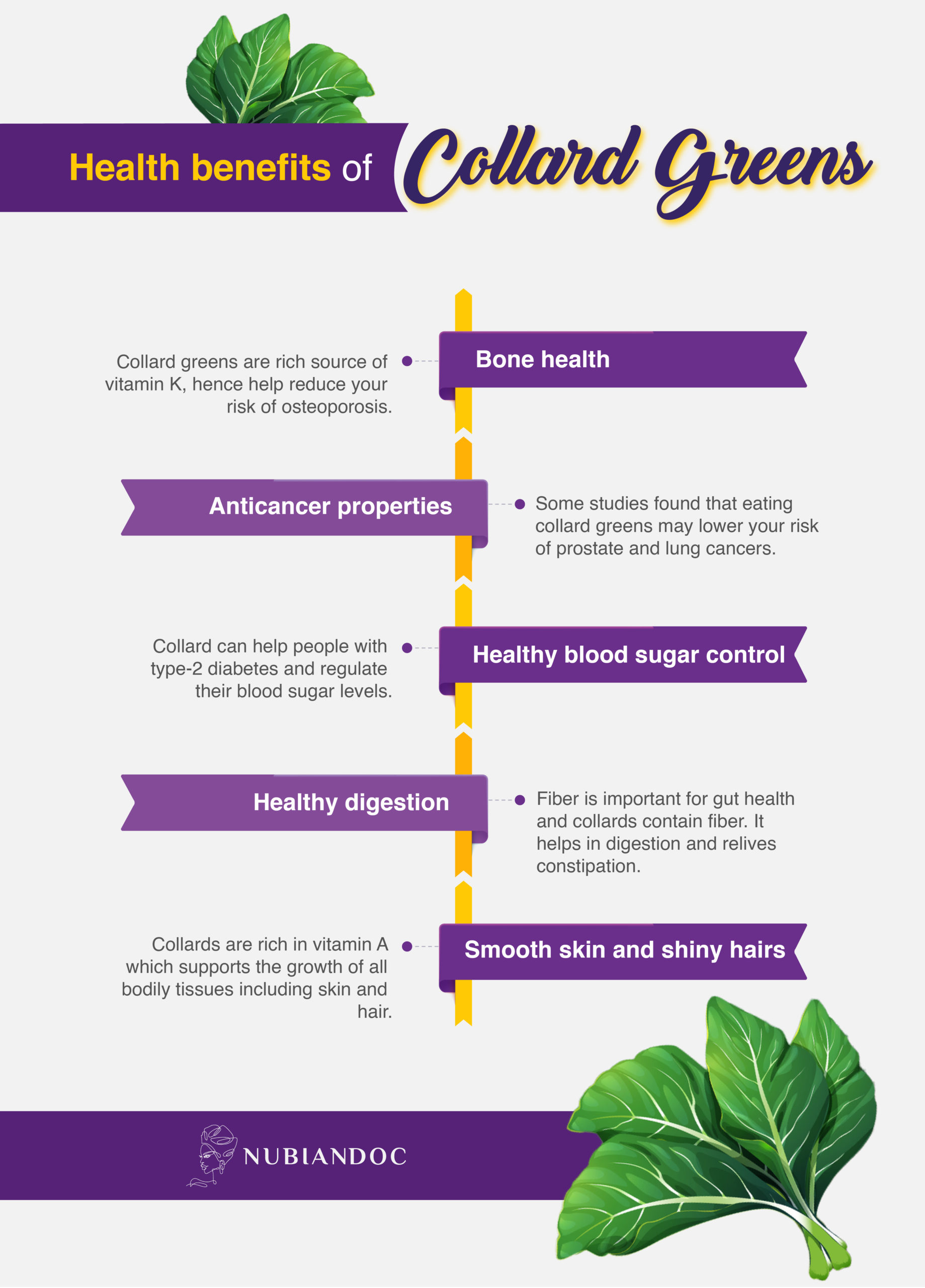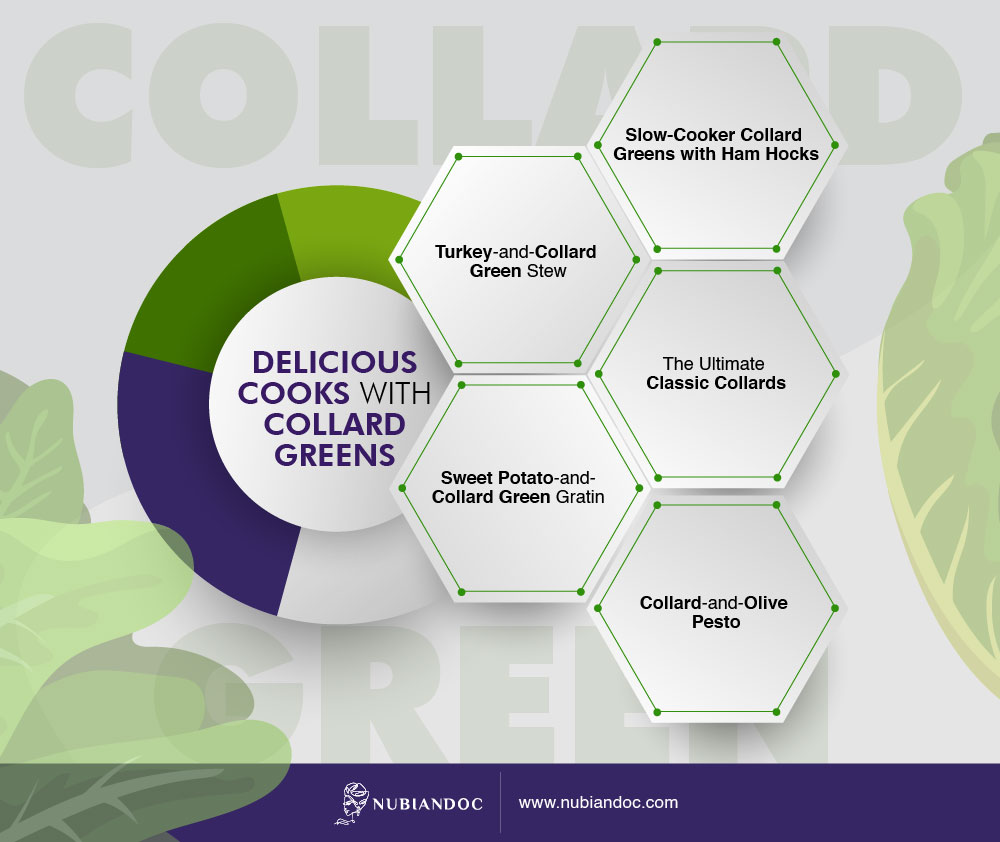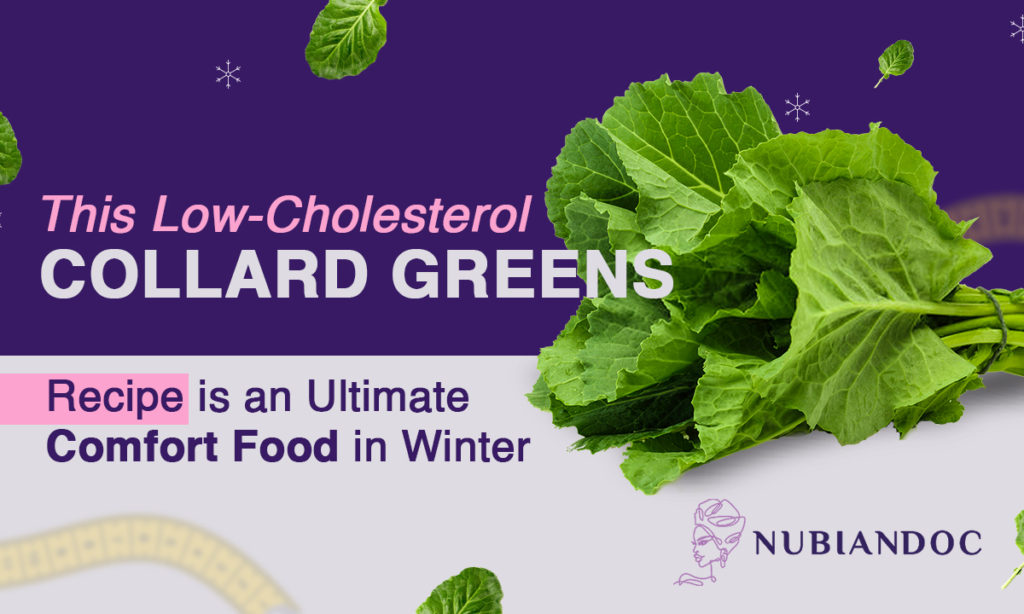Collard Greens: A Low-Cholesterol Food Recipe
What Are Collard Greens? | History | Places to Buy | Fun Facts | Health Benefits | Ways to Cook | Nutritional Composition | Healthy Recipe | As a Side Dish | Bottom line
When someone talks about Southern cuisine, the dishes that come to mind — fried chicken, grits, biscuits and broth – do not explicitly declare it “healthy”. Fortunately, Collard Greens, the basis of a reliable vegetable, is different.
“Like most dark Greens veggies, they pack a hefty nutrient punch”, says registered dietitian Rima Kleiner.
What are Collard Greens?
If you’re from the northern U.S, collard Greens may not be a regular item on your dinner table. Collards have dark green, fan-like leaves with thorny stems.
They share same features and are often modified alternately or in the same way (at least in the southern U.S, where they are most popular) with the same ingredients. Collards do well in dishes that require slow cooking, such as boiling, baking, with ham, beans, and okra among other foods.
Summary: Collard Greens is a leafy species of the genus Brassica oleracea, from the Acephala group. The Brassica genus includes several other vegetables such as cabbage and broccoli.
History of Collard Greens
Collard Greens are precursors of the cabbage family.
How was Collard Greens introduced in America?
Raw vegetables emerged near Greece, but it was not until the early Africans arrived, in Jamestown, Virginia in the early 1600s that the Americas discovered their first taste of dark, leafy greens.
The cooked vegetables became a small, delicious broth (known as “pot likker”) of African origin. The likker of the pot is nutritious and delicious and contributes to the luxury of the dish.
Summary: Collard Greens belong to the cabbage family, but they are also closely related to Kale. The fresh and finest ones are available in between January and April.
Places to Buy Collard Greens
Collards can now be found in many outlets of the food supply chain including Walmart and commercial giant Amazon. You can also buy collards from farmers’ markets, stored in batches, close to kale, Swiss chard, and other produce. Leaves are enormous and dense, therefore, hard to miss.
Summary: You can easily buy Collard Greens from your local grocery store or major distribution outlets in most cases.
Things to Look at while Buying Collard Greens
No matter where you buy from, look for strong stems and bright green leaves that are dense and large, almost as if you could use them as a shelter to cool off in the summer. Avoid yellow, dotted or leaves that are withered. Do not wash until ready to cook. When shopping at a farmers’ market or farm, ask farmers about their production methods.
Summary: Choose vegetables with strong, green leaves for freshness and high-quality nutrients, says Kleiner. Avoid yellow or brown greens.
Fun Facts about Collard Greens
The word Collard is derived from the Middle English word colewort, which means “cabbage plant.” (Finally, the mystery of coleslaw is solved!)
Collards won the least expensive cruciferous prize as it’s typically cheaper priced and very nutritious.

Collard Greens is Healthier than You May Think
After the American Civil War, destitute Southerners began eating collard Greens and found what African-Americans had known for ten generations: they are delicious and nutritious!
Collard greens are one of the most nutrient dense vegetables of cold season that help prevent ,and fight disease. Today, many varieties of Greens – Collard, mustard, turnips, chard, spinach, and kale – continue to be a staple food.
The health benefits of collard greens include detoxification, providing essential nutrients, preventing cancer, strengthening bones, supporting digestion, preventing anemia, lowering cholesterol levels and supporting hair growth. Other benefits include reducing the aging process, controlling diabetes and improving mood.
Summary: Collard Greens are high in vitamins A and C, manganese, folate, dietary fiber and, calcium and are an excellent source of potassium, vitamins B2 and B6. Like other vegetables in the brassica family, phytonutrients containing sulfur are believed to have antioxidant properties.
More Nutritious than Other Greens
As consistent with the facts supplied by the USDA, one cup of uncooked Collards has 11.5 calories and 0.22 grams of fat. It consists of 2 grams of carbohydrates and 1.4 grams of fiber.
It is more extraordinary than the dietary supplements supplied via bok choy or swiss chard. Moreover, while boiled, Collards offer greater fiber than the other vegetables.
Unlike the alternative greens, include 83.5 micrograms of calcium. Most Greens, such as Collard, are packed with nutrients.
Collard is likewise an excellent supply of vitamins C, K, A, folate, magnesium, beta-carotene, etc.

Some of the Other Health Benefits of Collard Greens
Improved B-One Health
Collard Greens have a high source of vitamin K, important in bone and heart health. As a result, collards may help reduce the risk of osteoporosis. vitamin K also plays an important role in blood clotting and preventing calcification of the artieries which plays a role in heart disease
Disease Prevention
Your body produces free radicals from regular metabolic processes. These free radicals can harm different cells, which mounting evidence indicates could cause cancer, coronary heart ailment ,and diabetes. Collard greens provide antioxidants that neutralize free radicals and thus likely reduce risk of certain cancers.
Prevent Birth Defects
Dark, leafy greens, such as collard greens, naturally provides folate. Folate is an essential vitamin that is crucial for growing individuals and women of reproductive age.
Improved Immune Health
Collard vegetables provide vitamin A and vitamin C, both of which are vital for your immune system. Vitamin C helps keep blood cells healthy and vitamin A is vital for healthy T-cells, part of your immune system.
Summary: Collard Greens are healthy for you, but of course with moderation. Collard Greens is rich in fiber, which can take longer to digest than other substances. Overeating fiber at one time can lead to side effects such as constipation or gas. Consuming more than a cup or two of Collard Greens at once is a great way to get their health benefits without stressing your stomach.
Different Ways to Cook Collard Greens while Retaining Nutrition
Among our other healthy recipes, you will find the following very easy to make.
1. Wraps
- You can use Collard for wraps. After washing the leaves properly, get rid of the thorny stems, put the fillings on them before wrapping the leaves up. Simple as that!
2. More Greens in your Salads
- Remove the stem and midrib then cut the collard leaves into chunk sizes
- Put them in a bowl with another Greens and herbs you would love to eat. For meat lovers, you could add ham or other meat products
3. Preserve the Leaves with Blanching
- Once again, reduce off the midrib of the Greens then boil salted water in a pot
- Perform blanching of leaves in the boiling water for two-three minutes and take off the extra water
- Let the cooked Collard cool on a layered sheet pan or dip in ice water to chill it faster
4. Sautéed Collard Greens
- Remove the center ribs of the collars and cut the leaves into pieces
- Soak the leaves in boiling water for 10-15 minutes
- Heat one tablespoon of olive oil in a frying pan and add the herbs, spices, and garlic
Summary: Collard Greens taste good when smoked for five minutes or seasoned with olive oil and spices. They are so easy to cook, that they work well by soaking them in boiling water for pasta or soup at the last minute. However, don’t overcook the collard greens – that’s when that spicy taste becomes overpowering.
Nutritional Composition of Collard Greens
| Principle | Nutrient Value | % of RDA |
| Energy | 32 Kcal | 1.5% |
| Carbohydrates | 5.42 g | 4% |
| Protein | 3.02 g | 6% |
| Total Fat | 0.61 g | 2% |
| Cholesterol | 0 mg | 0% |
| Dietary Fiber | 4 g | 10% |
| Vitamins | ||
| Folates | 129 µg | 32% |
| Niacin | 0.742 mg | 5% |
| Pantothenic acid | 0.267 mg | 5% |
| Pyridoxine | 0.165 mg | 13% |
| Riboflavin | 0.130 mg | 10% |
| Thiamin | 0.054 mg | 4.5% |
| Vitamin A | 5019 IU | 170% |
| Vitamin C | 35.3 mg | 59% |
| Vitamin E | 2.26 mg | 15% |
| Vitamin K | 437.1 µg | 37% |
| Electrolytes | ||
| Sodium | 17 mg | 1% |
| Potassium | 213 mg | 4.5% |
| Minerals | ||
| Calcium | 232 mg | 23% |
| Copper | 0.039 mg | 4.5% |
| Iron | 0.47 mg | 6% |
| Magnesium | 27 mg | 7% |
| Manganese | 0.658 mg | 30% |
| Selenium | 1.3 µg | 2% |
| Zinc | 0.21 mg | 2% |
| Phyto-nutrients | ||
| Carotene-ß | 2991 µg | — |
| Crypto-xanthin-ß | 28 µg | — |
| Lutein-zeaxanthin | 4323 µg | — |
A Healthy Collard Greens Recipe
Finally, let’s take a look at a Collard Greens recipe that promises healthy and nutritious dish if you eat it right. Here is a collard greens recipe to accompany the vegetarian southern style of vegetables and the healthy cornbread you learned in a previous blog.
Servings Prep Cooking Duration Serves
Four people 10 minutes 45 minutes 4
Ingredients
- Bunches of collard greens are washed with long stems and strong ribs
- Salt
- 1 teaspoon butter or vegan substitute
- add 1 tablespoon olive oil
- another 1 diced onion
- 2 cloves of garlic minced
- ½ teaspoon red peppercorns
- Quick sauce
Instructions
- Boil a large pool of water. Add a teaspoon of salt. Plunge the greens in the pot and cook for 10 minutes. Keep ½ a cup of cooking water , and remove the Collard Greens from the bowl.
- Cook the butter, olive oil, onion, garlic ,and pepper flakes, occasionally stirring until the onions are soft ,and the garlic is slightly golden.
- Add Collard Greens, boiled water and one teaspoon of salt. Cook for 20 to 30 minutes, stir occasionally.
- Taste and add extra salt if necessary.
- Serve with pepper sauce on the side.
Collard Greens as a Side Dish
Collard Greens make a delicious and easy side dish (they shrink tons once cooked; therefore cook a minimum of one pound of Collard Greens for every pair of servings). They are additionally good in soups, or combined with potatoes, pasta or beans. They are at their peak season from January through March or April, therefore best eaten in these months.
Summary: Since the collard Greens shrink a lot while cooking, it is great to serve them as a side dish with baked potatoes, meat and beans.

The Bottom Line
Collard Greens probably descended on wild cabbages found in Asia before recorded history. It eventually spread to Europe, and Greeks and Romans planted kale and Collard in private gardens 2,000 years ago. The Collard Greens sailed to the Americas and has become an integral part of the south.
Collard Greens is also known for packing nutritional values. High in vitamins and nutrients, dark, leafy vegetables contain high amounts of vitamins A, C, and K, calcium, folate, and fiber. Collard is rich in beta-carotene, an antioxidant that helps cells protect themselves from the free radicals. Beta-carotene may play a key role in preventing certain cancers, as stated by the National Cancer Institute.
It is important to remember, however, that Collard improper or overcooked – like other nutritious vegetables – can extract vitamins and minerals from the leaf. Reducing cooking time or simmering greens instead of boiling can help professional gourmets and beginners alike maintain the nutritional value and taste.
If you’re trying to lose weight with a healthy diet then NubianDoc is here for you. With our customized meal plans and workout regimine, you are sure to achieve your health and fitness goals. Contact us now.
Also, checkout our informative articles for guidance on health and fitness.
How long do you harvest collard Greens?
Although 60 to 75 days is the normal harvest time for planting collard Greens to reach maturity, the leaves can be formed at any time to be eaten from the bottom of large, non-edible stems.
How do you clean Collard Greens?
Remove any yellow or solid leaves as you separate the bouquet. Wash the leaves by swiping them vigorously in a bowl of cold water. Treat or spin the Greens to dry. Cut the stems strong and, if you like, the middle veins.
How long can you refrigerate cooked collard vegetables?
Cooked collard vegetables last up to a week if you keep them in the fridge. It is best not to do more than 3 to 4 days.



